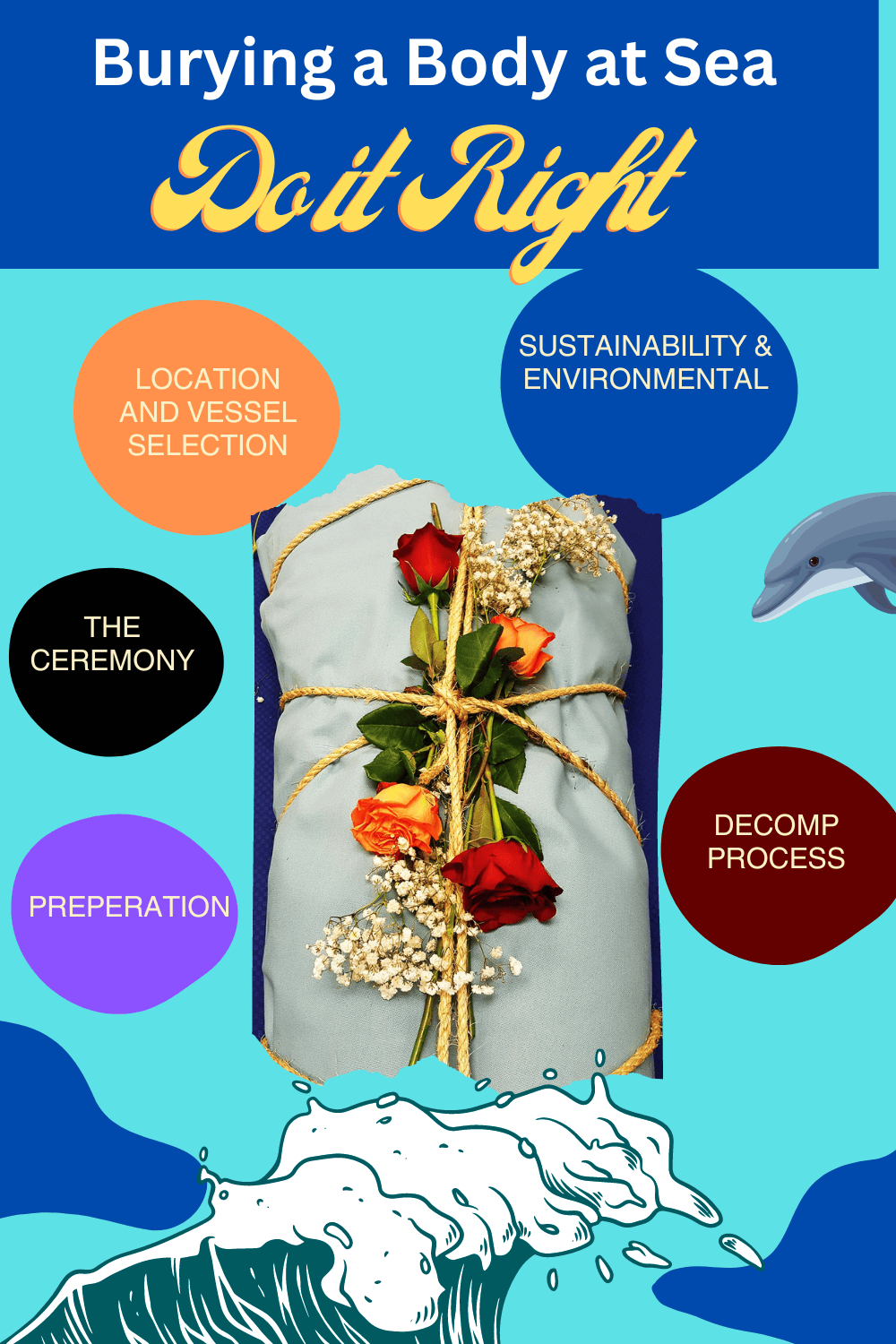Burying a body at sea is a time-honored practice with deep significance. Its symbolism stretches across cultures and religions for millennia. As an alternative to traditional land burials, this solemn ritual allows for a final farewell in the vast expanse of the ocean. With its beauty and power, the sea is a unique last resting place for those who have passed away. For this blog post, we delve into the process of burying a body at sea. We will explore the various aspects of this meaningful ceremony and the natural decomposition in the marine environment. For additional details, see our page regarding Full Body Burial at Sea.
The Ceremony for Sea Burial
A burial at sea – ocean burial – is often accompanied by a ceremonial tribute to honor the departed. The ceremony can take diverse forms, depending on cultural customs, personal beliefs, and the wishes of the deceased and their family.
Religious or spiritual readings, prayers, and personalized tributes are common elements that offer solace and create a meaningful atmosphere. If the departed were armed forces members, the ceremony might include military rituals, paying tribute to their service and sacrifice.
It is essential to have some service as a memorialization of the loved one and an acknowledgment of the life they lived. It is very much a part of the healing process for all involved.
Preperation for the Burying at Sea
Before the burial, meticulous preparations are taken to ensure a respectful and dignified farewell. The body is gently placed within a specially designed weighted shroud or casket, facilitating rapid sinking and natural decomposition. Detailed instructions regarding this are on our site. The purpose of the weight is to ensure that the body submerges to a significant depth, preventing resurfacing or disturbance by ocean currents. Attention to compliance with local maritime regulations and any specific requirements outlined by cultural or religious traditions is very important.
Location and Vessel Selection
The choice of the burial site and the selection of the vessel from which the ceremony occurs are crucial considerations. Burials at sea – ocean burials – usually occur in designated areas, far from shore and maritime routes, to ensure a serene resting place.
The location may be determined by maritime regulations or influenced by the deceased’s personal connection with the ocean. We prefer to bury in at least 2000 ft of water. A ship or boat is chosen as the platform for the ceremony, providing a stable and respectful setting to carry out the burial.
Sustainability and Environmental Considerations
Lately there has been a growing awareness of the environmental impact of burial practices. When opting for a burial at sea, it is essential to prioritize sustainable and eco-friendly approaches. Choose biodegradable materials for the weighted shroud or casket, minimizing the use of synthetic or harmful substances. As well, adhering to guidelines that protect marine ecosystems is a crucial step in ensuring a responsible burial.
By embracing environmentally conscious practices, burial at sea can become a tribute to the departed and a testament to our commitment to preserving the delicate balance of the ocean’s ecosystems.
Decomposition Process for Ocean Burials
Once the ceremonial aspects are concluded, the body is committed to the depths of the sea. Understanding the natural decomposition process that follows allows us to appreciate the cycle of life in the marine environment. The interaction between the body and the ocean unfolds gradually, influenced by various factors.
At the moment of submersion, the body begins its transformation through decomposition, recycling really. Autolysis sets in within hours to a few days when the body’s enzymes start breaking down cells and tissues.
The marine environment, with its vast array of bacteria and enzymes, facilitates the further breakdown of the body’s organic matter.
Full-body ocean burial promotes natural decomposition with minimal environmental impact. The carbon is sequestered in the ocean.
What happens during Discomposition During Sea Burial
Over time, scavengers and marine organisms are attracted to the body. Bacteria, crustaceans, and small fish contribute to the decomposition process by consuming the soft tissues. Depending on the prevailing environmental conditions, this stage can commence within a few days to weeks.
The colder water temperature at ocean depths, such as off the coast of San Diego, prolong the decomposition process. In such conditions, it may take several months to years for the soft tissues and organs to fully decompose, leaving behind skeletal remains.
The skeletal remains, resilient and enduring, become the final remnants of the once-living body. Factors like water currents, wave action, and the activity of marine organisms gradually contribute to the disintegration and dispersion of the skeletal elements. This process can span from several years to decades. When the bones become scattered or fragmented and ultimately become part of the intricate tapestry of the ocean floor.
Full Body Sea Burial – Conclusion
Burying a body at sea is a poignant and respectful way to bid farewell to loved ones, embracing the transformative power of the ocean. The ceremony, accompanied by rituals and personal tributes, allows for a peaceful transition of the departed into the embrace of the deep waters. Through the natural decomposition process that follows, the body becomes a testament to the cycle of life. In the marine environment, as it sustains organisms and becomes one with the eternal flow of the ocean.




